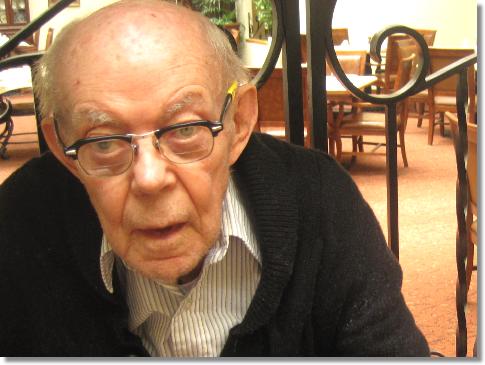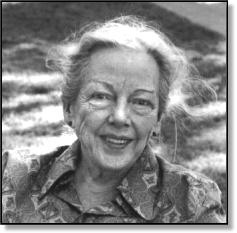 |
|
CHANCE SYNCHRONICITY & MIND-WRITING:
Write About Aging

My father, Bill Scheffel, in his last months of life.
St. Francis sang gently of his family: his brother the Sun, his sister the Moon. He talked of Brother Pain, who was as welcome and well-loved as any other visitor in a life filled with birds and beasts and light and dark. It is not always easy for us lesser people to accept gracefully some such presence as that of Brother Pain or his cousins, or even the inevitable visits of a possibly nagging harpy like Sister Age. But with a saint to guide us, it can be possible.
This story about the portrait of Ursula von Ott, a forgotten German or Swiss lady, may seem odd as an introduction to a collection of stories about aging and ending and living and whatever else the process of human being is about. I know, though, that my devastated old piece of painted leather, half eaten by oil-hungry insects when it was already worn with years, has been a lodestar in my life.
Before I found the picture in a junk-shop in Zurich, in about 1936, I was writing of old people who had taught me things I knew I needed, in spite of my boredom and impatience. And years later, after I had sent away the boxes of notes made in the several decades since I first met Ursula, I realized that all this time when I had thought I was readying myself to write an important book about the art of aging, I had gone on writing stories about people who were learning and practicing it long before I was.
Sometimes we met for only a few seconds. Probably the old Bible salesman who stumbled to our door at the Ranch did not remember me five minutes later, but he was the one who first taught me that people can cry without a sound, and without knowing why. It was a valuable lesson, and as mysterious now as it was when I was about twelve, watching him walk slowly out to the dusty road again, and feeling the cool new tears run down my cheeks. And I forgot it, for about thirty years.
Sometimes the meetings with Sister Age’s messengers are long, tedious, even unwitting. For instance, I knew my father’s father for almost twenty years, but we never really met, and certainly did not recognize each other as appointed teacher or pupil. By now I sometimes regret this, because I see him as possessing great strength and dignity that were mine for the taking. I doubt, though, that he felt much more interest in me than I in him. We were as impersonal as two animals of different sex and age but sharing some of the same blood, unaware that we lifted our hooves in a strangely similar way as we headed for the same hay-mangers, the same high hills. Even now I cannot feel any strong reason for making notes about him. But I may, I may.
Certainly there were violent flash-like meetings, all my life, with people much older than I, of different colors and sexes and social positions, who left marks to be deciphered later. This was the case with the Bible salesman: I did not think consciously of him for a long time (Why should I?), when suddenly I knew that I must add some words about him to the boxes of notes. .
The art of aging is learned, subtly but firmly, this way. I wrote fast, to compress and catch a lesson while I could still hear it, and not because it had happened to me, so that I was recording it, but because it was important to the whole study. It was, for the time I made the notes anyway, as clear as ringing crystal that such hints are everywhere, to be heeded or forever unheard by the people who may one day be old too.
So all the notes I took were caught on the run, as it were, as I grew toward some kind of maturity. I never thought of them as anything but clinical, part of the whole study of aging that Ursula von Ott was trying to help me with. I kept on checking dates and places and events, not at all about my own self but simply as a student in a class, preparing a term paper and leaving scraps that might be useful to other workers in the same field.
By now some of my notes sound like fabrications, invented to prove a point in an argument. This is because it is my way of explaining, and it has always been a personal problem, even a handicap. When I tell of a stubbed toe or childbirth or how to serve peacocks’ tongues on toast it sounds made-up, embroidered. But it is as it happened to me.
This may explain why I have spent my life in a painstaking effort to tell about things as they are to me, so that they will not sound like autobiography but simply like notes, like factual reports. They have been set down honestly, to help other students write their own theses.
M.F.K. Fisher, from Sister Age.
from DON'T GROW OLD
III.
Wasted arms, feeble knees
80 years old, hair thin and white
cheek bonier than I’d remembered —head bowed on his neck, eyes opened
now and then, he listened— I read my father Wordsworth’s Intimations of Immortality ... trailing clouds of glory do we come
from God, who is our home...”
“That’s beautiful,” he said, “but it’s not true.”
“When I was a boy, we had a house
on Boyd Street, Newark—the backyard
was a big empty lot full of bushes and tall grass, I always wondered what was behind those trees,
When I grew older, I walked around the block, and found out what was back there— it was a glue factory.”
May 18, 1976
IV
Will that happen to me?
Of course, it’ll happen to thee.
Will my arms whither away?
Yes yr arm hair will turn grey.
Will my knees grow weak & collapse?
Your knees will need crutches perhaps.
Will my chest get thin?
Your breasts will be hanging skin.
Where will go—my teeth?
You’ll keep the ones beneath.
What’ll happen to my bones?
They’ll get mixed up with stones.
Allen Ginsberg
June 1976

M.F.K. Fisher
The lessons that Fisher had learned in her first kitchen in Dijon in 1930, namely that she wanted her guests to forget “home” and all it stood for during the few hours when they were at her house, had become a basis for her cuisine personnelle. She made it a priority to cook meals that would shake diners from their routines, not only of meat-potatoes-gravy, but also of thought and behavior. She devised entrees consisting of a potato or cauliflower casserole, a grilled steak or fresh mushrooms baked in heavy cream. Then she served a fresh salad or marinated green beans, peppers, and endive. These early menus translated into an American idiom in subsequent kitchens in Laguna Beach and Eagle Park and into her short-lived period of cosmopolitan entertaining with Dillwyn Parrish, at Le Paquis in Vevey. In spring she served guests the first crop of peas, shelled, quickly blanched, and dressed with only a bit of fresh butter; in summer she thickened fresh fruit in its own syrup; and in autumn she prepared stews of vegetables. And when she and Parrish returned to the States and settled at Bareacres, her simple but distinctive culinary style distinguished their dining and entertaining.
A period of living alone in a one-room studio apartment in Hollywood and the constraints of caring for her daughter and often cooking a solitary meal for herself, however, added an element of eclecticism to Fisher’s cooking style. And this is what Donald Friede soon discovered and described. Fisher’s “nameless dishes” concocted from leftovers appeared at the table in a more delicious state than the one in which they were originally served. They were a tribute to her educated palate and ingenuity, as was the first meal of the day. While Donald Friede never departed from his fruit-eggs-toast-coffee routine established during his years of hotel, restaurant, and business breakfasts, Fisher viewed the first meal of the day as a “preamble.” A glass of vermouth, a heel-tap of last evening’s wine, a lamb chop carefully set aside or a plate of hot, buttered, grated zucchini were often as fanciful as the essay on dining alone or seducing a lover that she might write before lunch.
While the outlines of M.F.K. Fisher’s life are well-known from her first book (Serve It Forth, published in 1937) to her last (Last House, published posthumously in 1995), her three husbands have been relegated to either romantic shadows or vaguely realized mistakes. This despite the fact that all of them had the insight and ability to write volumes about the woman who has drawn readers into a magical circle of unforgettable family members, and into a cosmopolitan world of French landladies and winemakers, restaurateurs and waiters, academic friends, and scary street people. Fisher’s first husband, the poet and professor Alfred Young Fisher, only obliquely referred to his separation from his wife in a sonnet: “Those who once loved have, by mutation come/ to find themselves unrecognizable.”5 Dillwyn Parrish, Fisher’s second husband and an artist, painted the back of her shoulders and head but never attempted a portrait of her face. And her third husband, Donald Friede, left this short, but no less perceptive, appreciation. “On Being Married to M.F.K. Fisher” adds another insight. Although Fisher’s marriage to Donald Fried ended in a divorce that he didn’t want but she felt was necessary, their brief life together was a memorable feast.
by Joan Reardon
![]()
